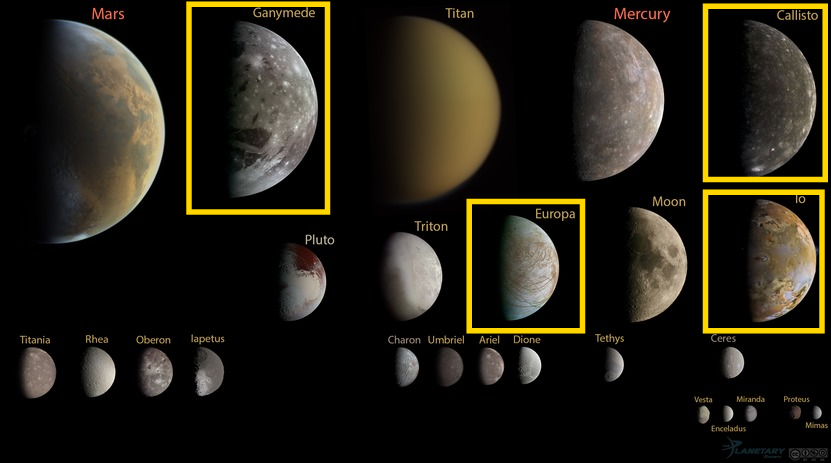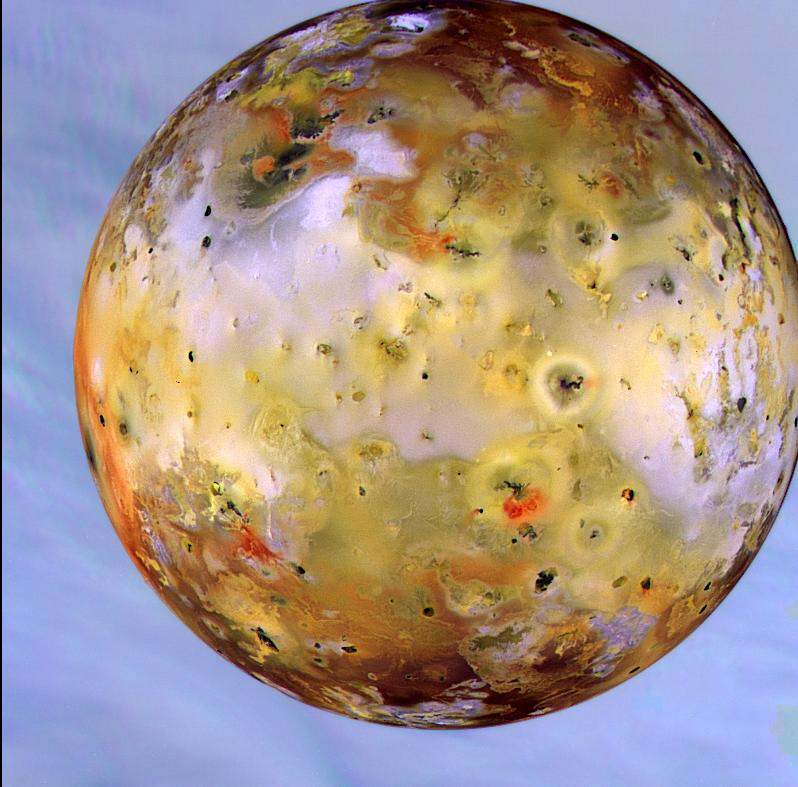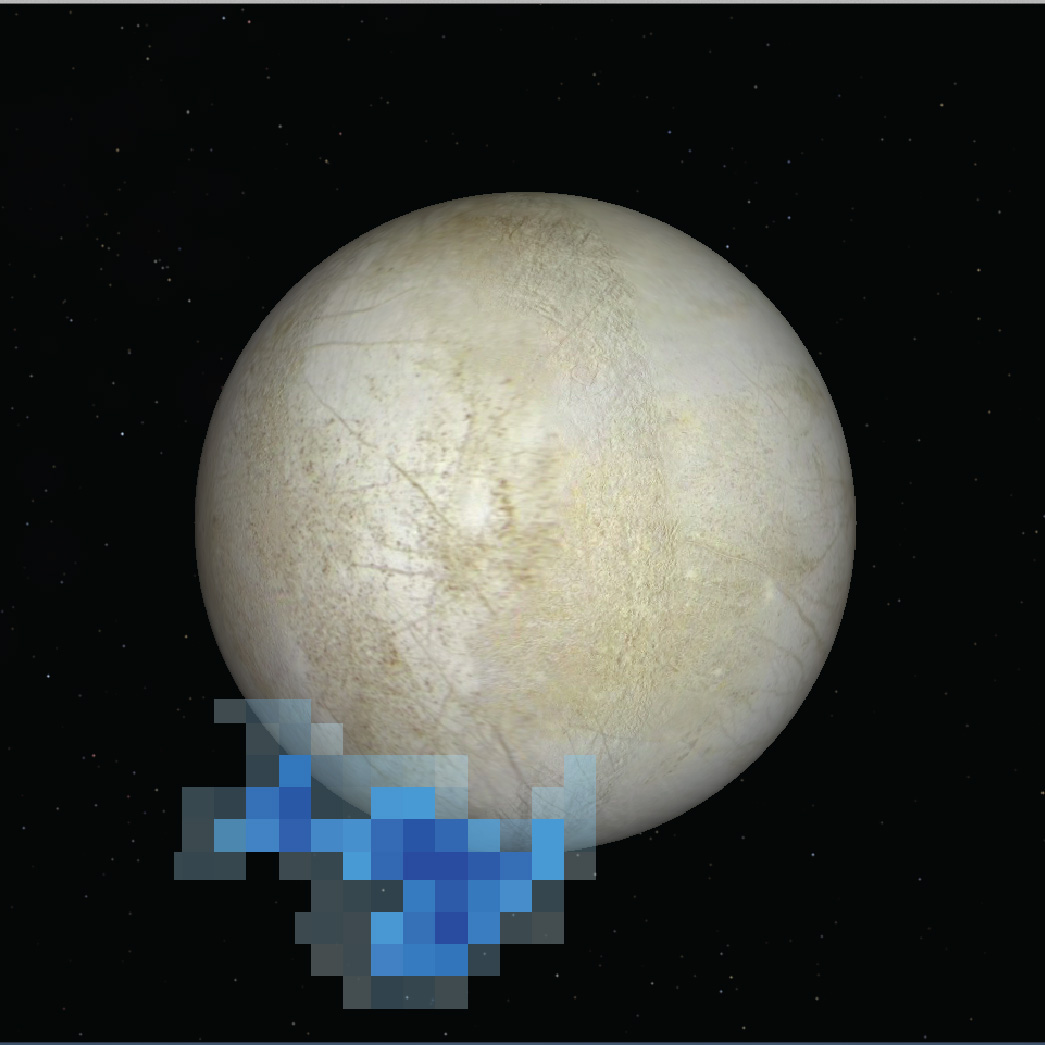
Montage by Emily Lakdawalla. Data from NASA / JPL, JHUAPL/SwRI, SSI, and UCLA / MPS / DLR / IDA, processed by Gordan Ugarkovic, Ted Stryk, Bjorn Jonsson, Roman Tkachenko, and Emily Lakdawalla.
 Copyright © Michael Richmond.
This work is licensed under a Creative Commons License.
Copyright © Michael Richmond.
This work is licensed under a Creative Commons License.
Today, we look at each of the four large moons of Jupiter, from the inside (closest to Jupiter) to the outside (farthest from Jupiter). Some of these moons are larger than a planet, so each one really is a world of its own.
The innermost moon of Jupiter, Io, looks crazy. It's more like a pizza than a moon!

Galileo image courtesy of
NASA/JPL
What's going on?
In 1979, as the Voyager 1 spacecraft flew past Io, it took an image that revealed something very strange near the edge of the moon.

Image courtesy of
NASA/JPL
What was this arc-like feature? The scientists spent several days trying to identify its source. Was it simply an image defect, or an artifact of the image processing system? Way back in 1979, the image processing tools were somewhat primitive, so the discussions and analysis took time.
Below, for example, are diagrams the JPL staff used to compare the brightness of the arc to the brightness of the limb of Io ...

Image courtesy of
Morabito, L. A., arXiv 1211.2554 (2012)
... and to determine the center of curvature of the arc feature.

Image courtesy of
Morabito, L. A., arXiv 1211.2554 (2012)
After three days of hard work, the JPL team announced that it had found active volcanos on Io, the first time anyone had seen such features beyond the Earth.
In the years since then, all the other spacecraft (Galileo, Cassini, New Horizons, Juno) which have visited Jupiter have also taken pictures of these volcanos. You can see material flying through space in this animation of a volcanic plume taken by the New Horizons spacecraft as it sped past Jupiter in 2013.

Image courtesy of
https://www.nasa.gov/topics/solarsystem/features/io-volcanoes-displaced.html
By comparing the images taken by different spacecraft, we can watch large-scale features appear and change over years and decades.

Image courtesy of
NASA/JHUAPL
Infrared instruments can sense the heat emitted from the active volcanic regions. Comparing those maps with optical images allows us to figure out which features are currently active.

Image courtesy of
NASA/JPL-Caltech/Bear Fight Institute
Planetary geologists have identified a boatload of active volcanic regions on the surface of Io.

Image courtesy of
NASA/JPL-Caltech/Bear Fight Institute
Here's a closeup showing some lava flowing from a volcanic vent.

Image courtesy of
NASA/JPL
Q: How many craters do you see in that image?
Yes, there are very few craters on Io, so we can't do a very good job of estimating the age of the surface. Why not? Because the frequent volcanos completely replace the surface over short periods of time; I've read estimates from every few thousands of years to every million years or so.
So, the big question is -- WHY is Io so angry? What is producing all the energy to form the volcanos?
The answer is a complex interplay of factors involving the orbits of Io and Europa around Jupiter.
The combination of an eccentric orbit and a synchronous rotation period mean that Io is STRETCHED and then RELAXED over the course of every orbit; in other words, every 1.8 days.

Image courtesy of
Lsuanli and Wikimedia
This constant flexing and squeezing by gravitational tidal forces heats the interior of Io, driving all the volcanic activity.
The second moon in the sequence from Jupiter is Europa. The image below provides a true-ish color view on the left, and an enhanced version on the right which highlights differences in the surface composition.

Image courtesy of
NASA/JPL-Caltech/DLR
In one way, Europa lacks dramatic surface features. It doesn't have tall mountains or deep valleys; instead, its surface is pretty darn flat. It looks a bit like a giant cue ball. One reason for the lack of mountains is that the surface appears to be made largely of icy materials, rather than rocky ones. Icy materials lack the strength to hold large, heavy collections of mass against the levelling force of gravity.
But in other respects, Europa is a VERY interesting world. Its light-colored surface is criss-crossed by long, linear features. These may be cracks or ridges in the frozen surface, related in some way to changing temperatures. If the surface were to warm up briefly, become liquid or slush, and then cool off again, it would shrink as it cooled, perhaps leading to these cracks.

Image courtesy of
NASA/JPL/University of Arizona/University of Colorado
An entire planet with a crust made of ices, instead of rocks? But the Earth's crust is mostly rock -- there is just a very thin layer of liquid water at the very top. And Mercury's crust is mostly rock. And Venus', and Mars'. Rock, rock, rock.
Q: Why would icy materials be so common in the vicinity
of Jupiter?
The simple answer is because it is COLD so far away from the Sun. When the solar system was forming, little grains of solid material clumped together to form dust, then pebbles, then planetesimals. But close to the Sun, the temperatures were so high that very common materials like water ice, ammonia ice, methane ice, all melted, evaporated, and sublimated. Only rocky materials with high melting temperatures were left to form the inner planets.

Figure 2 taken and modified from
Morbidelli et al., Icarus, 267, 368 (2016)
What is the typical temperature of an object at Jupiter's distance from the Sun?

Far from the Sun, temperatures were so low that these common materials -- water, ammonia, methane -- remained in solid form as ice crystals. The crystals clumped together to form ice-pebbles, which clumped together to form ice-planetesimals, which eventually formed icy moons and other small bodies.
freezing temperatures
--------------------------------
water 273 K
ammonia 196 K
methane 91 K
--------------------------------
Let's look at Europa's overall mass and size. Perhaps its density will give us a clue to its internal composition.
Europa: radius R = 1560 km
mass M = 4.8 x 1022 kg
Q: What is Europa's overall density?
How does it compare to the density of the Earth?
How does it compare to the density of water?
It appears that Europa must contain a mix of some rocky parts, and some icy parts.
But in recent years, it has become clear that Europa has some LIQUID in large quantities close to its surface. The Hubble Space Telescope detected plumes of water vapor just above the surface of Europa.

Image courtesy of
NASA/ESA/L. Roth/SWRI/University of Cologne
The idea is that Europa may have oceans of liquid water underneath the outer layer of ice.

Image courtesy of
NASA
The water is kept warm and liquid by tidal heating due to Jupiter's strong gravitational field, in a manner similar to Io.

Image and movie courtesy of
NASA/JPL
Some scientists have been designing a spacecraft which might visit Europa specifically to test the idea that a giant sub-surface ocean really does exist: the Europa Clipper mission. If this mission is approved, it might launch in the early 2020s.

Image courtesy of
NASA/JPL-Caltech
Ganymede is big; it is not only the largest of Jupiter's moons, but the largest moon in the entire Solar System.

Image courtesy of
Gregory H. Revera and Wikimedia
Its surface has a mixture of textures and patterns.

Image courtesy of
NASA/JPL
The darker regions are covered with more craters, while the lighter regions have many fewer craters and a curious series of "grooves".

Image courtesy of
NASA/NSSDCA
In some locations, one set of grooves cuts across another set.

Image courtesy of
NASA/JPL/Brown University
Planetary geologists can count craters and use the distribution of craters as a function of size to estimate the age of the surface of Ganymede. The dark regions may be around 4.2 billion years old, while the lighter, grooved areas only 2 - 3.6 billion years old.

Figure 2 taken from
Seddio and Schenk, "Lunar and Planetary Science XXXVIII (2007)
If one compares the crater distributions on Ganymede to those on Europa and Callisto, one sees that Europa's surface is far younger, while Callisto's is slightly older.

Figure 18.13 taken from
Schenk, Chapman, Zahnle and Moore,
"Ages and Interiors: the Cratering Record of the Galilean Satellites,"
(2015)
Callisto is covered with craters. Lots and lots of them.

Image courtesy of
NASA/JPL/DLR
It lacks some of the interesting surface features of the other Galilean moons: no grooves, no long cracks. Just lots of craters.

Image courtesy of
NASA/JPL/DLR
The large number of craters indicate that the surface of Callisto is very old, about 4.3 billion years old; that's almost as old as the formation of the Solar System itself. Apparently, there has been very little geologic activity on Callisto.
The activity of these four big moons can be described as
most active <---------------------> least active
Io Europa Ganymede Callisto
Q: Does this sequence look familar to you? If so, can you explain it?
Yes, it appears that the farther a moon is from Jupiter, the less its interior may be heated, and so the lower its level of geologic activity. That makes sense.
There's another pattern one can see in the moons, too. Let's compute the density of Callisto:
Callisto: radius R = 2410 km
mass M = 1.1 x 1023 kg
Q: What is Callisto's overall density?
How does it compare to the density of the Earth?
How does it compare to the density of water?
How does it compare to the density of Europa?
The densities of these moons also decrease with distance from their host planet.
kg per cubic meter
most dense <---------------------> least dense
Io Europa Ganymede Callisto
3480 3020 1930 1840
Q: Can you explain this sequence? Why should the density
change with distance from Jupiter?
We've seen how the temperature in the proto-SOLAR nebula had a strong gradient, with high temperatures near the Sun and lower temperatures far away. High temperatures near the Sun prevented icy materials from forming into solid bodies.
But why can't the same thing happen in the proto-JUPITER nebula?

Image courtesy of
Judit Szulagyi
 Copyright © Michael Richmond.
This work is licensed under a Creative Commons License.
Copyright © Michael Richmond.
This work is licensed under a Creative Commons License.